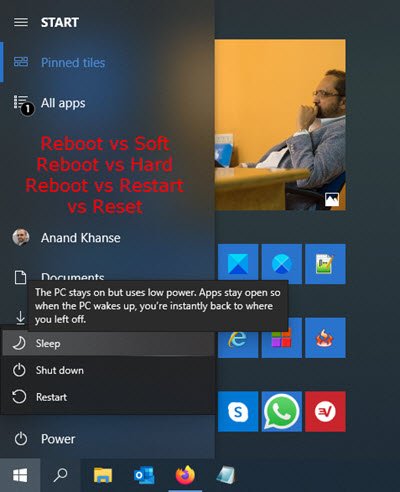I am sure you have heard about all these terms if you are using a Windows 11/10 PC, or even a phone. While they might sound similar, there are differences between them. Should you know them? Honestly, it will hardly matter because, on the exterior, all you get is a restart, shutdown, and log off buttons. Nevertheless, it is a good idea to know about it. In this post, we will make a quick comparison between Soft Reboot, Hard Reboot, Restart, and Reset.

Soft Reboot vs Hard Reboot vs Restart vs Reset difference
1] Reboot
It is a process where computers initiate two processes. The first is to shut down the computer and then start it again. Shutdown closes all inputs and outputs of the computer, saves all work, and terminates any process which is causing a bottleneck. Once it shuts down the computer, it reloads the operating system again. It effectively resets the laptop on the hardware level and initiates the sequence of loading the OS.
There are two types of Reboots, and one of the types is responsible for Windows 11/10 to boot faster than its previous versions.
Hard Reboot
You can manually try Hard Reboot. Press and hold the Power button on the computer to turn off. Disconnect your connected external devices. Turn on the computer after 10-15 seconds.
When I leave from office, I power down everything. The next day, I power everything on and turn on my computer. When there is no power, the computer physically shuts down, and all hardware states are reset. This is a hard reboot.
Soft Reboot
When you restart the computer using ALT + Ctrl + Del or power down using the Start menu, then the computer hardware state is not reset. In simple words, a soft reboot means the computer restarts without loss of power.
Read: How to force a Windows full shutdown to reinitialize it?
2] Restart
The difference between Restart and Reboot is hairline. Restart is the action that initiates the Reboot of the OS. When you click on the Power button on the start menu, you get to RESTART the computer. However, when the computer does, it reboots the OS.
Read: How to Emergency Restart or Shutdown Windows?
3] Reset
While Restart or Reboot reloads the OS again, Reset means Windows 11/10 goes through the reinstallation of the OS from scratch. Windows offers this as an essential feature, but reset in earlier versions of Windows meant, creating a bootable USB, and reinstalling the OS again. The same happens in Windows, but you don’t need to download the ISO to do that. You can also perform a cloud reset where Windows will download the latest OS, and install it.
During Reset, it will wipe all the data on the Primary Partition, remove applications, and only install what comes with the original Windows 11/10. If you choose to keep personal data, then whatever you have, the folders like document, music, etc. will be safe.
Read next: Reset vs Clean install vs In-place Upgrade explained.
What is the difference between Hard restart and Soft restart?
A soft restart involves rebooting the computer without cutting off power, typically executed through the operating system or a reset button. In contrast, a hard restart requires turning off the power completely and then powering the device back on, akin to a full shutdown and restart cycle.
What is the difference between Hard booting and Soft booting?
Hard booting refers to restarting a system by cutting power and restoring it, similar to switching a machine off and on. Soft booting involves rebooting the system using software commands without cutting power, such as using the reboot command in an operating system, ensuring data integrity and quicker recovery.
Leave a Reply